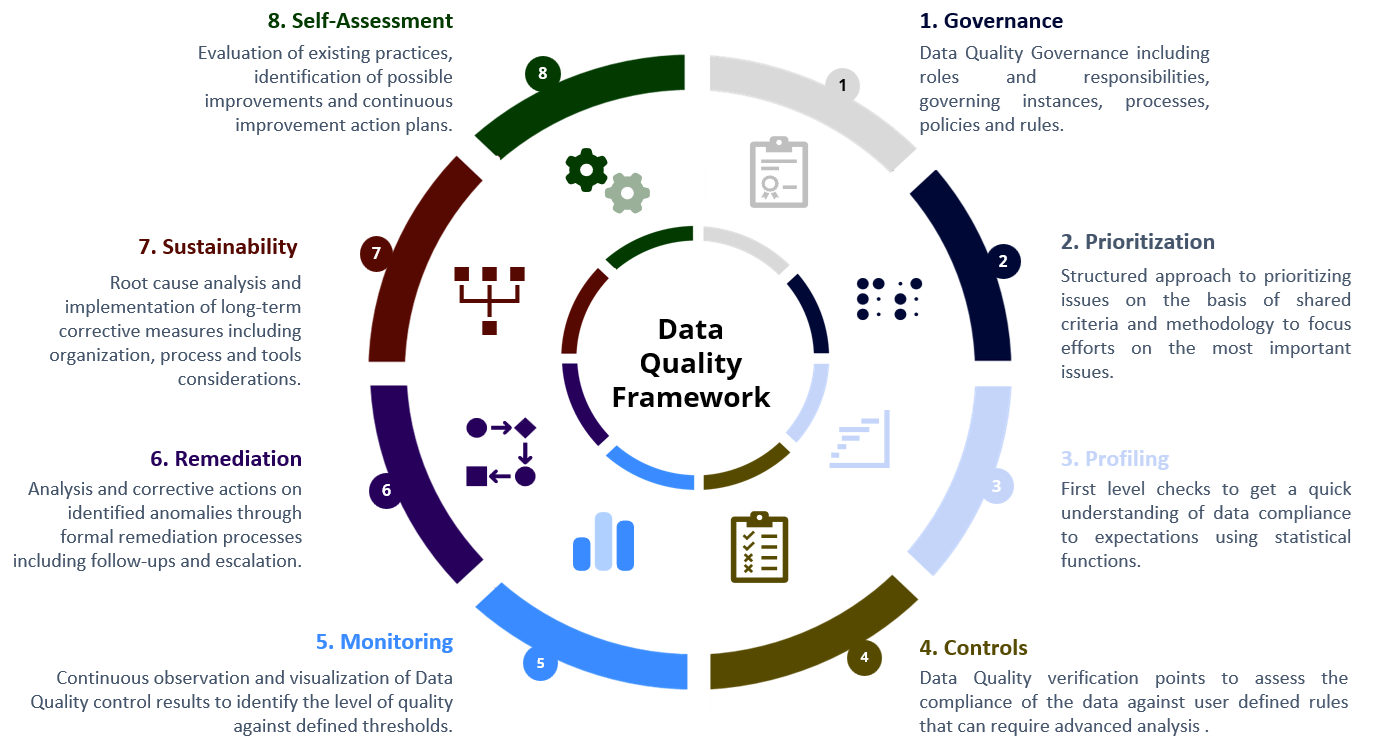Key capabilities of the Data Quality Framework
The Data Quality Framework Wheel
The scope of this Data Quality Framework encompasses the methodologies, standards, processes, tools, progress monitoring, and governance structures required to ensure high-quality data across the enterprise, from data collection to data analysis and reporting. Built around eight essential capabilities, this framework forms the foundation of the enterprise’ data quality practice, ensuring that data is accurate, reliable, and actionable.

While comprehensive, this framework could be costly to be fully implemented, especially for business lines with a low level of maturity in terms of data quality management. In order to help business lines to manage data quality, three data quality capabilities grouping from the framework have been identified as foundational (Profiling & Controls, Monitoring and Remediation & Sustainability) and a set of key data quality assets have been identified to support their implementation:
Profiling & Controls: Data quality controls per data domain
Monitoring: Data quality dashboards and reporting in Data Governance tool and Data Quality Data Mart
Remediation: Data quality backlog
Sustainability: Periodic data quality and KPIs assessment standard process
Collaboration Model
The intended audience for the Data Quality Framework includes a wide range of stakeholders within the enterprise who are involved in or impacted by Data Quality Management. E.g., Governance, Advisory Board, the enterprise Data Office, Business Data Offices, Business Lines’s R&D Teams, Legal, CISO, etc.
Successful data quality management implies a company-wide effort, sustained in time, and an iterative deployment approach.
As a central team, ADO manages the definition of common standards and guidelines, provides templates and tools where necessary, supports local implementations and maintains an oversight on progress through monitoring and follow-ups. It falls upon the BDOs within the Business Lines to implement these overarching guidelines, adapting them as needed to address specific demands, including business requirements and regulatory obligations within their respective Business areas.
Content of Data Quality Framework
To achieve a consistent approach to Data Quality at the enterprise level, the DQF provides a common ground on different DQ aspects that apply to different data types and scenarios. The content of the framework is structured as follows:
High-level overview of data quality framework
On each of the eight capabilities presented above, the following content is provided to build actionable capabilities:
Objectives & Benefits: Outlines what are the objectives and the expected benefits.
Methodology: Presents a structured approach to executing the activities related to each of the Data Quality capability. E.g. Steps involved in prioritization, profiling, controls, monitoring,
Standards: Specifies established guidelines, rules, and specifications established to ensure uniformity, consistency, and accuracy. E.g. guideline for prioritization, profiling, monitoring.
Tools: Provides a list of identified tools to implement Data Quality capabilities. E.g. Tools for profiling, monitoring, remediation.
Progress monitoring: outlines expected information to be provided from BDOs to ADOs to monitor framework capabilities deployment progress.